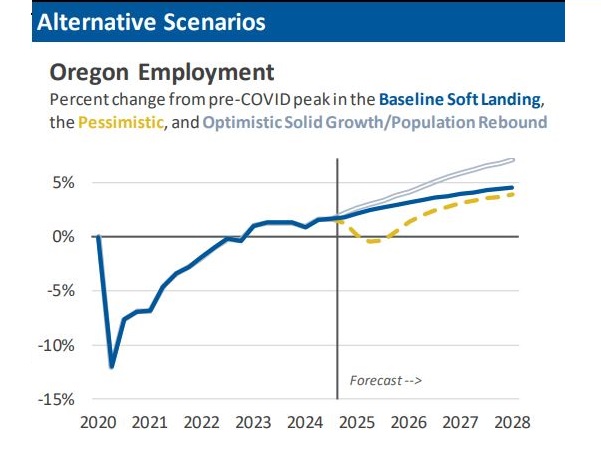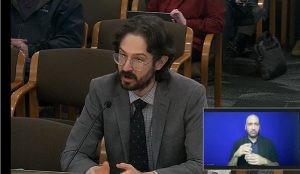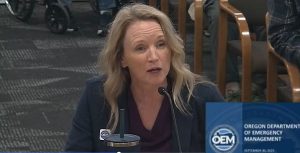Governor asks $2.1 billion for housing and homelessness
5 min read
from the Office of the Governor, Department of Economic Analysis, and staff reports
Gov. Tina Kotek unveiled her 2025-2027 recommended budget Dec. 2. With a Democratic supermajority in both houses of the Oregon Legislature, and the state economist seeing moderate improvement ahead, the governor highlighted investments in housing and homelessness, behavioral health, and education in a statement accompanying the budget.
Homelessness: Infrastructure and partnerships
The Governor’s 2025-2027 budget commits more than $700 million to address homelessness, including:
- $217.9 million to maintain Oregon’s statewide system of shelters. The Oregonians who are still spending the night on our streets are relying on statewide support and we cannot afford to allow our progress to stall.
- $188.2 million to maintain current efforts to transition Oregonians out of homelessness and into housing. The Oregon Rehousing Initiative gets Oregon families into safe, stable housing, and keeps them there.
- $173.2 million to maintain services to prevent Oregonians from becoming homeless in the first place. The most cost effective strategy to combat our homelessness crisis is to prevent people from becoming homeless in the first place.
Housing supply: Building the Oregon that’s possible
The 2025-2027 recommended budget continues to focus on increasing Oregon’s housing supply in every part of the state by committing more than $1.4 billion including:
- $880 million new bond authority to build more affordable housing and homeownership pathways. The recommended budget reflects a dogged commitment to meet the state’s housing production goals and includes $780 million to build affordable rental homes and $100.9 million for new homeownership units.
- $100 million to establish a new housing infrastructure program. These new funds will establish a new housing infrastructure program to fund water, sewer, stormwater, and transportation infrastructure linked to new housing development to unlock thousands of new affordable and market rate rental and homeownership units.
- $57.6 million to continue efforts for supporting first-time home buyers and Oregonians looking to buy an affordable home. Homeownership is out of reach for many working families, keeping Oregonians from building wealth over the long term. This investment supports homeownership development and homebuyer assistance.
Behavioral Health: Closing gaps in services
The 2025-2027 Governor’s Recommended Budget focuses on closing gaps in services by building treatment capacity and supporting a strong behavioral health workforce. It commits more than $330 million, including:
- $90 million in General Fund backfill of ARPA investments for capacity building. The Governor’s budget includes a $90 million investment towards capacity building for adult mental health services, substance use disorder residential treatment, and withdrawal management.
- $50 million General Fund backfill from ARPA to strengthen workforce investments. Governor Kotek is focused on increasing the supply and distribution of a diverse and culturally responsive behavioral health workforce by investing $25.7 million in behavioral health education and training programs, wrap-around supports for students, and tuition assistance and scholarships, and investing $24.3 million in graduate stipends, loan repayment, and peer and manager support for the community mental health workforce.
- $40 million to continue deflection services through the Criminal Justice Commission. The funding supports deflection coordinators, peers and counselors who give individuals struggling with addiction the opportunity to avoid legal consequences and to seek treatment instead.
Children and Youth: Investing for a stronger, healthier future
Building on her education initiative work, Gov. Kotek recommends committing more than $835 million, including:
- $600 million increase to strengthen the State School Fund Current Service Level (CSL) for a total of $11.36 billion. The Governor is recommending a three-pronged approach to adjusting funding for the State School Fund to move the needle on student outcomes and provide more accurate and predictable funding for K-12 public education across Oregon, along with adjusting the calculation to account for the recent PERS rate increase.
- $205.5 million to provide additional targeted funding to help more students get on track for success. By recommending $127 million to maintain and strengthen previous early literacy investments and $78.5 million to expand and make ongoing investments in summer learning programs, Oregon’s students will get more help to overcome pandemic learning loss.
- $25 million for youth behavioral health investments. Governor Kotek is recommending new investments in targeted residential and community-based behavioral health and substance use disorder capacity, expansion of mental health services, prevention services for school-based health centers, and funding to expand youth suicide prevention work.
The budget follows a state economic forecast for higher revenue. The most recent quarterly forecast by the Office of Economic Analysis, released Nov. 20, said the national economy appears on course to experience a post-pandemic “soft landing,” which means successfully reducing inflation without causing a recession. “As a result, the State of Oregon similarly faces improving economic prospects heading into the 2025-27 biennium,” the analysts concluded.
“At the state level, Oregon’s economy is currently demonstrating moderate health. Output growth is lagging the national statistics but is showing some signs of reacceleration. Net job creation remains positive, but it is concerning to see job creation concentrated in just a few industry categories.”
However, the economists also warned that “escalation of a tariff or trade war—particularly with major trading partners like China—could negatively impact Oregon’s key exports, such as timber, wheat, wine, and hazelnuts. These products rely heavily on international demand, and tariffs or restrictions could reduce export volumes, drive down prices, and harm associated industries like transportation and warehousing.”
In her statement accompanying the proposed budget, the governor said, “As I approach the halfway mark of my first administration and take stock of where we have been and where we are going, I fundamentally believe the Legislature needs to pass budgets for the next two years that build on the progress we have achieved together.”
In her first two years, the governor said she has visited Oregon’s 36 counties, nine federally-recognized Tribal nations, and consulted with the Governor’s Racial Justice Council. “These conversations have helped inform my approach to decision-making and have strengthened my ability to be a governor for the whole state,” she said.
“My approach to being your governor will always be grounded in truth, pragmatism, and a relentless pursuit of equitable outcomes for all Oregonians,” Gov. Kotek said. “The December revenue forecast projects stability for Oregon, and I am pleased to share that my budget does not lay off people or cut services, and instead strategically deepens our commitment to building progress on Oregonians’ top priorities while remaining disciplined when it comes to new programs.”






